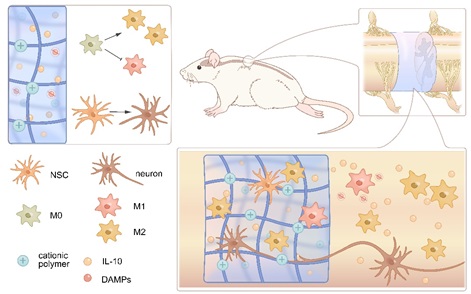Spinal cord injury causes axon damage and neural cell death, leading to dysfunction. Spinal cord injury is divided into two stages: primary injury and secondary injury, which is initiated by the primary injury and lasts for several weeks. Spinal cord injury -triggered infiltration and activation of immune cells creates an inflammatory microenvironment characterized with damage-associated molecular patterns (DAMPs) that exacerbates secondary damage and impairs neurological functional recovery.
In a study published in Biomaterials (DOI:10.1016/j.biomaterials.2021.121279),the research group led by Prof. DAI Jianwu from the Chinese Academy of Sciences developed a multifunctional scaffold by modifying a photocrosslinking gelatin hydrogel with a cationic polymer, polyamidoamine, and an anti-inflammatory cytokine, interleukin-10 (IL-10), to effectively regulate the immune microenvironment after spinal cord injury, reduce secondary injury effects, enhance tissue remodeling and promote axonal regeneration.
Figure Schematic diagram of the dual-functional immunoregulatory hydrogel for regulating the inflammatory microenvironment after spinal cord injury. (Image by IGDB)
With the capabilities of effective scavenging of DAMPs and sustained release of IL-10, such a dual-functional immunoregulatory hydrogel not only reduced pro-inflammatory responses of macrophages and microglia, but also enhanced neurogenic differentiation of neural stem cells. In the complete transection SCI mouse model, the scaffold counteracted the inflammatory microenvironment by suppressing cytokine production, regulating immune cell activation, leading to the neural regeneration and axon growth without scar formation. The dual-functional immunoregulatory scaffold with neuroprotection and neural regeneration effects significantly promoted electrophysiological enhancement and motor function recovery after spinal cord injury.
This study demonstrated reconstructing immune microenvironment by functional scaffolds can be a promising and efficient strategy for treatment of severe spinal cord injury.
Contact:
Dr. DAI Jianwu
Institute of Genetics and Developmental Biology, Chinese Academy of Sciences
Email: jwdai@genetics.ac.cn
 Figure Schematic diagram of the dual-functional immunoregulatory hydrogel for regulating the inflammatory microenvironment after spinal cord injury. (Image by IGDB)With the capabilities of effective scavenging of DAMPs and sustained release of IL-10, such a dual-functional immunoregulatory hydrogel not only reduced pro-inflammatory responses of macrophages and microglia, but also enhanced neurogenic differentiation of neural stem cells. In the complete transection SCI mouse model, the scaffold counteracted the inflammatory microenvironment by suppressing cytokine production, regulating immune cell activation, leading to the neural regeneration and axon growth without scar formation. The dual-functional immunoregulatory scaffold with neuroprotection and neural regeneration effects significantly promoted electrophysiological enhancement and motor function recovery after spinal cord injury.This study demonstrated reconstructing immune microenvironment by functional scaffolds can be a promising and efficient strategy for treatment of severe spinal cord injury.Contact:Dr. DAI JianwuInstitute of Genetics and Developmental Biology, Chinese Academy of SciencesEmail: jwdai@genetics.ac.cn
Figure Schematic diagram of the dual-functional immunoregulatory hydrogel for regulating the inflammatory microenvironment after spinal cord injury. (Image by IGDB)With the capabilities of effective scavenging of DAMPs and sustained release of IL-10, such a dual-functional immunoregulatory hydrogel not only reduced pro-inflammatory responses of macrophages and microglia, but also enhanced neurogenic differentiation of neural stem cells. In the complete transection SCI mouse model, the scaffold counteracted the inflammatory microenvironment by suppressing cytokine production, regulating immune cell activation, leading to the neural regeneration and axon growth without scar formation. The dual-functional immunoregulatory scaffold with neuroprotection and neural regeneration effects significantly promoted electrophysiological enhancement and motor function recovery after spinal cord injury.This study demonstrated reconstructing immune microenvironment by functional scaffolds can be a promising and efficient strategy for treatment of severe spinal cord injury.Contact:Dr. DAI JianwuInstitute of Genetics and Developmental Biology, Chinese Academy of SciencesEmail: jwdai@genetics.ac.cn CAS
CAS
 中文
中文




.png)
